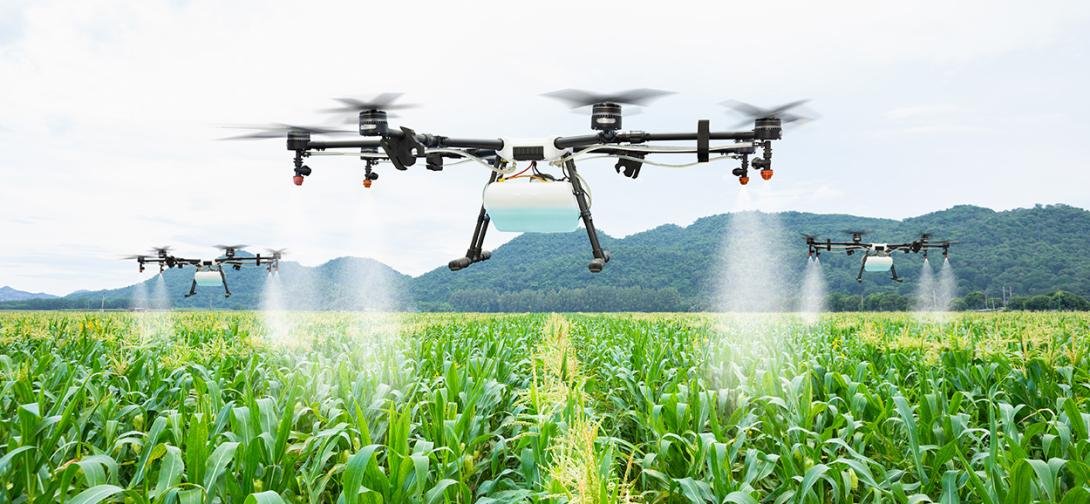The global population is projected to reach nearly 10 billion by 2050, amplifying the demand for agricultural output by approximately 50% compared to 2013. Agriculture, a cornerstone of economies worldwide, contributes not only to employment generation but also significantly to national income and economic prosperity. In developed nations and developing countries alike, the agricultural sector plays a pivotal role, with its growth directly influencing rural development, leading to structural transformation. In India, for instance, the agricultural sector constitutes 18% of the GDP and employs half of the country’s workforce.
Amid this backdrop, the convergence of technology and agriculture is becoming increasingly evident. Despite being one of the least digitized sectors, agriculture is experiencing a surge in technological advancements, particularly in the realm of Artificial Intelligence (AI). AI, a transformative force across various industries, is now making significant inroads into agriculture, revolutionizing traditional practices and paving the way for sustainable farming.
The Rise of AI in Agriculture
The integration of AI into agriculture is catalyzing a paradigm shift in the way farmers approach cultivation, resource management, and decision-making. With roots in diverse domains such as Biology, Linguistics, Computer Science, Mathematics, Psychology, and Engineering, AI seeks to replicate human brain functions. This emulation of human cognitive processes enables the development of intelligent software and systems capable of learning, decision-making, and problem-solving.
The core components of AI, namely Machine Learning (ML) and Deep Learning (DL), are pivotal in this transformation. ML, with its ability to learn without explicit programming, and DL, which involves deep neural networks, form the backbone of AI applications in agriculture. The overarching goal of AI in agriculture is to simplify problem-solving, leveraging technologies like Artificial Neural Networks (ANN), which draw inspiration from the human brain’s design and functionality.
AI Applications in Agriculture
The impact of AI on agriculture is multifaceted, spanning various dimensions crucial for sustainable farming practices.
- Image Recognition and Perception: Autonomous Unmanned Aerial Vehicles (UAVs) equipped with AI-driven image recognition technology are increasingly employed in agriculture. These UAVs play a pivotal role in tasks such as crop monitoring, surveillance, and disease detection, contributing to precision agriculture
- Skills and Workforce Enhancement: AI enables farmers to access and analyze vast amounts of data, providing solutions to complex issues. It is reshaping farming into a blend of technological and biological skills, offering more efficient and quality-oriented farming practices.
- Maximizing Output: AI assists in crop selection, seed quality enhancement, and the selection of hybrid seeds tailored to specific environmental conditions. By understanding how seeds react to various factors, AI minimizes the risk of diseases, ensuring farmers can meet market trends and consumer needs, and maximizing crop returns.
- Chatbots for Farmers: AI-powered chatbots, using natural language processing and machine learning, provide personalized interactions. In agriculture, these chatbots offer farmers answers to queries, advice, and recommendations, facilitating smarter irrigation and efficient farming.
Role of AI in Automated Agriculture
Automated agriculture, facilitated by AI, encompasses a range of technologies designed to enhance productivity, reduce labor requirements, and optimize resource utilization.
- Irrigation: AI-based irrigation systems have replaced traditional methods by incorporating real-time data. These systems use sensors to measure soil moisture, atmospheric conditions, and crop factors, ensuring precise and efficient water usage. Automated models with sensors and controllers enable smart irrigation, responding to real-time data to meet the specific needs of crops.
Robots in Agriculture: Robotics and Autonomous Systems (RAS) are transforming agricultural production. Robots perform tasks such as weeding, irrigation, and monitoring, enhancing precision and efficiency. Autonomous agricultural tools, driven by AI, are replacing human labor and improving production on both small and large scales.
Impact of AI on Water Management in Agriculture
AI is pivotal in addressing one of agriculture’s most critical challenges: water management. With the agriculture sector consuming a substantial 85% of global freshwater resources, AI-based solutions are crucial for optimizing water usage.
Automated irrigation systems, equipped with AI algorithms, determine irrigation schedules based on factors like plant evapotranspiration, soil moisture, and atmospheric conditions (Shekhar et al., 2017). Technologies like Machine-to-Machine (M2M) communication facilitate seamless data sharing among agricultural nodes, ensuring efficient water resource management.
Weed Management:
Addressing the historical challenge of weed management, Thomas K. Pavlychenko’s research highlighted water competition among plants, emphasizing the economic impact of weeds on agriculture, with India facing annual losses exceeding $11 billion. Leveraging AI, researchers introduced vision-based weed detection technology, utilizing genetic algorithms and morphological characteristics for precise identification. Modern weed control methods prioritize non-contact solutions like laser treatments and micro-spraying, facilitated by agricultural robots equipped with advanced vision systems for effective differentiation between crops and weeds. The synergy of AI and weed management offers promising avenues for sustainable and efficient agriculture.
Drones In Agriculture
Drones, also known as unmanned aerial vehicles (UAVs) or unmanned aerial systems (UAS), have found widespread application in agriculture, revolutionizing traditional farming practices. Equipped with GPS and various sensors, drones play a crucial role in crop health monitoring, irrigation equipment supervision, weed identification, herd and wildlife monitoring, and disaster management. These aerial systems leverage remote sensing technology, capturing, processing, and analyzing images to provide valuable insights into agricultural processes. Multispectral sensors, integrated into drones, offer a deeper understanding of plant growth factors such as moisture content in the soil and overall plant health. The seamless integration of drones with Wireless Sensor Networks (WSN) enhances their functionality, allowing for precise and controlled actions, such as targeted chemical spraying. In precision agriculture, drones prove instrumental in soil and field analysis, crop monitoring, crop height estimations, and pesticide spraying. The agricultural drone market is poised for substantial growth, driven by the increasing need for efficient farming practices to meet the demands of a growing global population and evolving climate patterns.
Applications of Drones in Agriculture:
- Crop Health Monitoring
- Irrigation Equipment Monitoring
- Weed Identification
- Herd and Wildlife Monitoring
- Disaster Management
- Soil and Field Analysis
- Crop Monitoring
- Crop Height Estimations
- Pesticide Spraying
Challenges & Future Scope
In addressing the challenges faced by agriculture, including inadequate irrigation, temperature variations, groundwater scarcity, and food waste, the industry looks toward the adoption of cognitive solutions for a sustainable future. While ongoing research and available applications show promise, the agriculture sector remains underserved, especially in employing autonomous decision-making solutions.
unlock the vast potential of AI in agriculture, robust applications are needed to handle dynamic external conditions, enable real-time decision-making, and efficiently collect contextual data. The high cost of cognitive solutions poses a barrier to widespread adoption, emphasizing the need for more affordable options, possibly through open-source platforms.
AI technology holds promise in predicting weather conditions, optimizing crop cycles, and mitigating concerns related to high-yield farming. Challenges such as crop damage due to disasters and pest attacks can be addressed through AI-driven solutions, including image recognition and drone monitoring. As agriculture embraces AI, it becomes a transformative force, revolutionizing practices and contributing to the global challenge of feeding a growing population amidst changing climate patterns.
All Inclusive
The integration of Artificial Intelligence (AI) into agriculture presents a pivotal opportunity to overcome longstanding challenges and usher in a new era of sustainable and efficient farming practices. The application of AI-driven technologies, including machine learning, image recognition, and autonomous systems, holds immense potential for addressing issues such as irrigation management, weed identification, and crop monitoring. The ongoing research and development in this field are crucial for enhancing the robustness and affordability of AI solutions, ensuring their accessibility to a broader segment of the farming community.
As the world population continues to grow, and climate change exerts pressure on traditional farming methods, AI emerges as a crucial ally in achieving the necessary advancements for increased food production and resource optimization. The transformative impact of AI in agriculture extends beyond addressing current challenges; it paves the way for a more sustainable and resilient global food production system. The ongoing collaboration between technology innovators, researchers, and the agricultural community will be instrumental in realizing the full potential of AI, ensuring a future where smart farming practices contribute to food security and environmental stewardship.
References
https://www.sciencedirect.com/science/article/pii/S258972172030012X?via%3Dihub
Abdullahi et al., 2015H.S. Abdullahi, F. Mahieddine, R.E. Sheriff
Technology Impact on Agricultural Productivity: A Review of Precision Agriculture Using Unmanned Aerial Vehicles
Lecture Notes of the Institute for Computer Sciences, Social Informatics and Telecommunications Engineering (2015), pp. 388-400
CrossRefView in ScopusGoogle Scholar
Ahir et al., 2020Ahir, K., Govani, K., Gajera, R., Shah, M., 2020. Application on virtual reality for enhanced education learning, military training, and sports. Augmented Human Research (2020) 5:7.
Ahirwar et al., 2019S. Ahirwar, R. Swarnkar, S. Bhukya, G. Namwade
Application of drone in agriculture
Int. J. Curr. Microbiol. App. Sci., 8 (1) (2019), pp. 2500-2505





